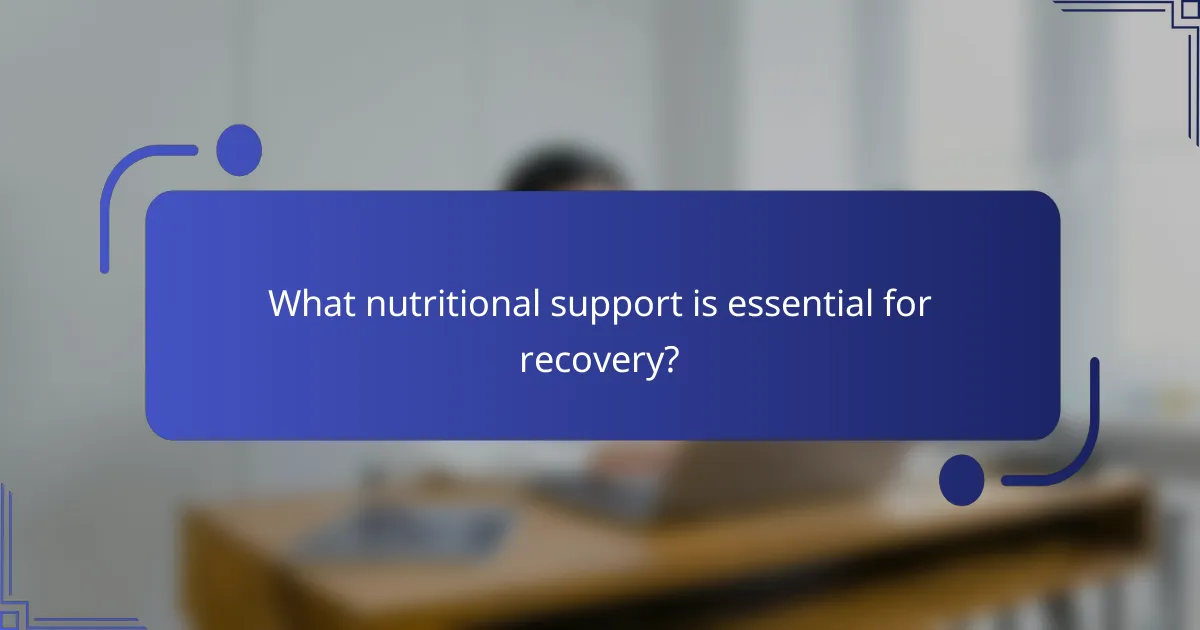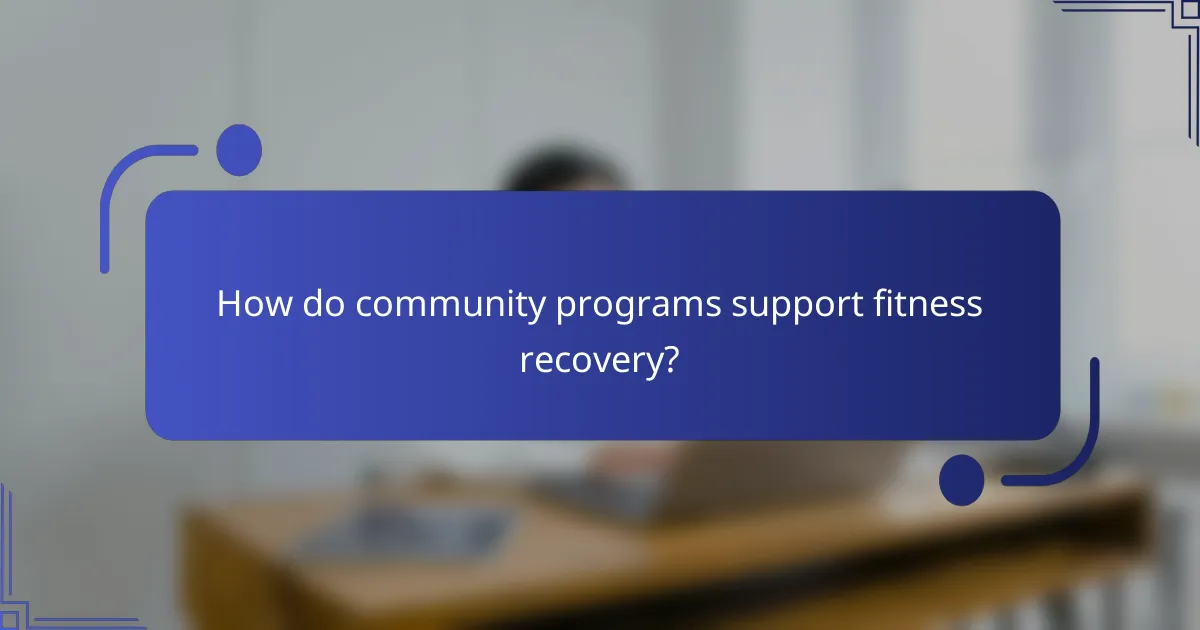Effective fitness recovery is essential for enhancing performance and preventing injuries. This article explores techniques like active recovery and proper hydration, the role of nutritional support including proteins and carbohydrates, and the benefits of community programs for motivation and accountability. Understanding these aspects can significantly improve recovery outcomes and overall wellness.

What are the key techniques for effective fitness recovery?
Effective fitness recovery involves techniques such as active recovery, proper hydration, adequate sleep, and nutritional support. These methods enhance muscle repair and reduce soreness.
Active recovery, like low-intensity exercises, promotes blood circulation and speeds up recovery. Hydration is crucial; it aids in nutrient transport and muscle function. Sleep allows the body to repair tissues and restore energy levels.
Nutritional support includes consuming protein for muscle repair and carbohydrates for energy replenishment. Community programs, such as group fitness classes or recovery workshops, foster motivation and provide shared knowledge, enhancing recovery outcomes.
How does active recovery enhance performance?
Active recovery enhances performance by promoting blood flow, reducing muscle soreness, and facilitating faster recovery. Engaging in low-intensity activities, such as walking or cycling, helps clear metabolic waste from muscles. This process supports muscle repair and prepares the body for subsequent workouts. Additionally, active recovery can improve flexibility and range of motion, contributing to overall athletic performance.
What role does stretching play in recovery?
Stretching plays a crucial role in fitness recovery by enhancing flexibility, reducing muscle soreness, and improving circulation. It helps alleviate tension in muscles, which can facilitate faster recovery after intense workouts. Regular stretching also promotes joint health and can prevent injuries by maintaining muscle elasticity. Incorporating stretching routines into recovery plans can lead to better overall performance and well-being.
Which massage techniques are most beneficial for recovery?
Massage techniques that enhance recovery include deep tissue, sports, and trigger point therapy. Deep tissue massage alleviates muscle tension by targeting deeper layers, while sports massage focuses on specific muscle groups used in athletic activities. Trigger point therapy addresses localized areas of tightness, promoting relaxation and blood flow. Each technique aids in reducing soreness, improving flexibility, and enhancing overall recovery.
How do breathing exercises aid in recovery?
Breathing exercises significantly aid recovery by enhancing oxygen flow, reducing stress, and promoting relaxation. These exercises improve lung capacity, which supports better endurance and faster muscle recovery. Incorporating deep breathing techniques can lower cortisol levels, facilitating a more effective healing process. As a result, athletes and individuals recovering from injuries can experience improved mental clarity and physical performance.

What nutritional support is essential for recovery?
Essential nutritional support for recovery includes proteins, carbohydrates, vitamins, and minerals. Proteins aid muscle repair, while carbohydrates replenish glycogen stores. Vitamins and minerals support overall health and immune function. For optimal recovery, consume a balanced diet with adequate hydration.
Which macronutrients are critical for muscle repair?
Protein, carbohydrates, and fats are critical macronutrients for muscle repair. Protein provides amino acids essential for muscle recovery, while carbohydrates replenish glycogen stores. Fats support overall health and hormone production. Each macronutrient plays a unique role in optimizing recovery and performance.
How do hydration levels impact recovery?
Hydration levels significantly impact recovery by facilitating nutrient transport and reducing muscle soreness. Adequate hydration enhances metabolic processes, which are crucial for repairing tissues after exercise. Dehydration can lead to fatigue and prolonged recovery times, hindering overall fitness progress. Monitoring hydration helps optimize recovery strategies, ensuring athletes can perform at their best.
What are the benefits of supplements for recovery?
Supplements enhance fitness recovery by reducing muscle soreness, improving nutrient absorption, and promoting faster healing. They support the body’s repair processes through essential vitamins, minerals, and amino acids. For instance, protein supplements provide the building blocks necessary for muscle repair, while omega-3 fatty acids can reduce inflammation. Additionally, branched-chain amino acids (BCAAs) may decrease muscle damage and enhance recovery time. Overall, incorporating supplements can significantly improve recovery outcomes for athletes and fitness enthusiasts.
Which foods are best for post-workout recovery?
The best foods for post-workout recovery include protein-rich options like chicken, fish, and legumes, along with carbohydrates such as sweet potatoes and quinoa. These foods help repair muscles and replenish glycogen stores. Consuming a mix of protein and carbs within 30 minutes post-exercise enhances recovery. Hydration is also crucial; including water or electrolyte drinks supports overall recovery.

How do community programs support fitness recovery?
Community programs play a crucial role in supporting fitness recovery by fostering social connections and providing structured environments. These programs often include group workouts, educational workshops, and peer support networks, which enhance motivation and accountability. Participants benefit from shared experiences and encouragement, leading to improved mental and emotional well-being. Additionally, community programs can offer access to resources such as nutrition counseling and fitness coaching, which are essential for holistic recovery. Engaging in these programs can significantly accelerate the recovery process and promote long-term wellness.
What types of group recovery sessions are available?
Group recovery sessions include support groups, fitness classes, and workshops. These sessions foster community, accountability, and shared experiences among participants. Support groups provide emotional guidance, while fitness classes focus on physical recovery through structured activities. Workshops often cover nutrition and wellness strategies, enhancing overall recovery.
How do peer support networks enhance recovery?
Peer support networks significantly enhance recovery by providing emotional support, shared experiences, and accountability. These networks foster a sense of belonging, which can reduce feelings of isolation during the recovery process. Participants often report increased motivation and commitment to their fitness goals through mutual encouragement. Additionally, peer support can offer practical advice on techniques and nutritional strategies, enhancing overall recovery outcomes. Research indicates that individuals engaged in peer support are more likely to adhere to recovery plans and achieve long-term success.
Which local organizations offer recovery resources?
Local organizations offering recovery resources include community fitness centers, wellness programs, and support groups. These entities provide various services such as nutritional guidance, exercise classes, and mental health support. For example, many local gyms host recovery workshops and partner with nutritionists to enhance overall wellness. Additionally, nonprofit organizations often facilitate group sessions for shared experiences and motivation.

What are the common challenges faced during recovery?
Common challenges during fitness recovery include physical limitations, mental fatigue, nutritional deficiencies, and lack of support. These obstacles can hinder progress and prolong recovery time.
Physical limitations often arise from injuries or muscle soreness, restricting movement and performance. Mental fatigue can lead to decreased motivation and adherence to recovery routines. Nutritional deficiencies may result from inadequate intake of essential nutrients, impacting energy levels and healing. Lastly, lack of support from community programs or peer networks can leave individuals feeling isolated, further complicating their recovery journey.
How can mental barriers affect recovery progress?
Mental barriers can significantly hinder recovery progress by creating self-doubt and anxiety. These psychological obstacles may lead to decreased motivation and engagement in fitness activities. Addressing mental barriers through techniques such as mindfulness and positive reinforcement can improve outcomes. Community support programs also play a crucial role by fostering a sense of belonging, which helps individuals overcome mental challenges.
What injuries are most prevalent during recovery phases?
Common injuries during recovery phases include muscle strains, ligament sprains, tendonitis, and stress fractures. These injuries often occur due to inadequate rest, improper technique, or returning to activity too quickly. Muscle strains typically affect the hamstrings and quadriceps, while ligament sprains often involve the ankle or knee. Tendonitis can develop in the shoulder or elbow, and stress fractures are frequent in weight-bearing bones. Proper rehabilitation and gradual progression help mitigate these risks.
How do lifestyle factors influence recovery outcomes?
Lifestyle factors significantly influence recovery outcomes by impacting physical and mental well-being. Regular exercise enhances muscle repair and reduces recovery time. Nutritional support, such as adequate protein intake, is crucial for tissue regeneration. Community programs provide social support, which can improve motivation and adherence to recovery plans. Stress management techniques, like mindfulness, promote mental resilience during recovery. Each of these factors contributes uniquely to optimizing fitness recovery.

What innovative trends are emerging in fitness recovery?
Innovative trends in fitness recovery include advanced technologies, personalized nutrition, and community engagement. Wearable devices track recovery metrics, while tailored diets enhance muscle repair. Group recovery sessions foster motivation and accountability. These trends emphasize a holistic approach to fitness recovery.
How is technology shaping recovery practices?
Technology significantly enhances fitness recovery practices through innovative techniques, nutritional support, and community programs. Wearable devices track recovery metrics, providing personalized insights. Virtual platforms connect individuals to recovery resources and expert guidance. Advanced recovery tools, such as cryotherapy and infrared therapy, optimize muscle repair. Nutritional apps help users manage their diets for better recovery outcomes. Community programs foster support networks, encouraging accountability and shared experiences. These advancements lead to more effective and efficient recovery practices for individuals.
What role do wearables play in monitoring recovery?
Wearables play a crucial role in monitoring recovery by providing real-time data on physiological metrics. They track heart rate, sleep patterns, and activity levels, which help users understand their recovery status. This data can identify overtraining signs and optimize recovery strategies. For example, wearables can suggest rest days based on heart rate variability, enhancing overall fitness recovery.
Which new recovery modalities are gaining popularity?
New recovery modalities gaining popularity include cryotherapy, infrared saunas, and active release techniques. These methods enhance muscle recovery and reduce inflammation. Cryotherapy uses extreme cold to accelerate healing, while infrared saunas promote detoxification and relaxation. Active release techniques focus on soft tissue mobilization to relieve tension and improve flexibility. Each modality offers unique benefits tailored to various recovery needs.
How do cultural differences influence recovery approaches?
Cultural differences significantly influence fitness recovery approaches by shaping techniques, nutritional support, and community programs. For example, some cultures emphasize holistic practices, while others prioritize scientific methods.
Nutritional support varies widely; traditional diets may focus on local ingredients that promote recovery, such as fermented foods in some Asian cultures. Community programs often reflect cultural values, fostering group support or individualism based on societal norms.
Understanding these differences enables fitness professionals to tailor recovery strategies effectively, enhancing outcomes for diverse populations.
What best practices can optimize fitness recovery?
To optimize fitness recovery, implement techniques like active recovery, prioritize nutritional support, and engage in community programs. Active recovery, such as low-intensity workouts, enhances blood flow and reduces muscle soreness. Nutritional support focuses on adequate protein intake and hydration, which are crucial for muscle repair. Community programs offer social support, motivating individuals to adhere to recovery routines. These practices collectively improve recovery times and enhance overall fitness outcomes.


